Stoplight Parrotfish
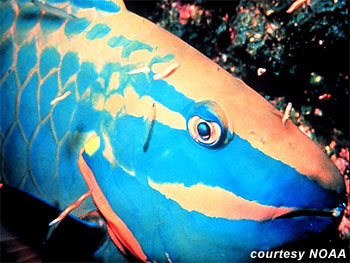
Sparisoma viride
This colorful reef fish has an elongated body with a bluntly rounded face and an elaborately curved crescent tail fin. It goes through significant color changes through the three major phases of its life, but it retains its large, plate-like scales and its beak-like mouth. These parrotfish can change their gender in times when there is a strong population imbalance between breeding males and females.
Order: Perciformes
Family: Scaridae
Genus: Sparisoma
Species: viride
Common Names
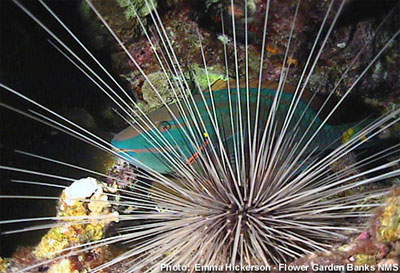
Common english names for S. viride include: stoplight parrotfish, dark green parrotfish, moontail, parrot chub, and red belly. Other language common names include jabon (Spanish), loro (Spanish), loro colorado (Spanish), loro verde (Spanish), loro viejo (Spanish), perroquetfeu (French), and sparysoma szmaragdowa (Polish). The common name “parrotfish” refers to the teeth’s resemblance to the beak of these tropical birds.
Importance to Humans
The stoplight parrotfish is of only minor commercial fisheries importance. It has been linked to reports of ciguatera poisoning. This fish is highly prized for public aquarium show tanks.
Conservation Status
> Check the status of the stoplight parrotfish at the IUCN website.
The IUCN is a global union of states, governmental agencies, and non-governmental organizations in a partnership that assesses the conservation status of species.
Geographical Distribution
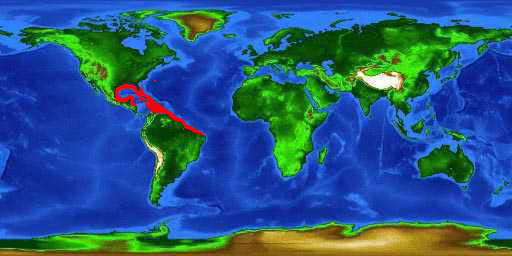
The stoplight parrotfish is found in the tropical western Atlantic Ocean, including southern Florida, Bermuda, Bahamas, and throughout the Caribbean Sea, south to Brazil. It also occurs along the eastern and western boundaries of the Gulf of Mexico.
Habitat
Occurring in shallow waters from 10-164 ft (3-50 m) in depth, the stoplight parrotfish is common in waters around coral reefs. This fish is strictly diurnal, spending the night sleeping on the reef in fairly open spaces where it is able to quickly escape from predators. Parrotfishes, along with wrasses, swim with their pectoral fins. These fins make quick vertical movements, propelling the fish forward. The caudal fin is used for quick bursts of speed.
Biology
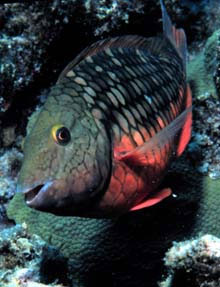
Distinctive Features
Large, heavy scales and a beak-like jaw formed from fused teeth are characteristic of parrotfishes. The different species of parrotfishes can be distinguished from each other by the upper and lower teeth structure. In parrotfish of the genus Sparisoma, the upper teeth fit inside the lower teeth. However, in the genus Scarus, the upper teeth stick out, covering the lower teeth. Further inside the mouth, there are plate-like pharyngeal teeth located in the back of the throat. These teeth are used in crushing coral skeletal materials that are ingested as the fish feeds on corals. The body is oblong and moderately compressed with the head being bluntly rounded with one row of scales on the cheek. The caudal fin of S. viride is truncated in young, emarginate in the intermediate phase, and lunate in large adult males. The stoplight parrotfish can be distinguished from other species based on its color patterns.
Coloration
Coloration of the stoplight parrotfish varies greatly, dependent upon what phase the fish is in. During the initial phase, both males and females are mottled reddish brown, often mixed with white scales, on the upper two thirds of the body while the belly is bright red. There are horizontal rows of five pale spots located on the flanks. The dorsal fin and second half of the caudal fin are reddish brown, the anal and pectoral fins are bright red, and the first half of the caudal is white.
As juveniles, the stoplight parrotfish has three rows of white spots running the entire length of the body, over a dark reddish-brown body. The belly is paler in color and there is a white bar on the caudal fin.
Terminal phase males are green with diagonal orange bands on the upper half of the head. There is an orange cresent-shaped indentation on the caudal fin. A yellow spot is located near the top of the gill slit and another at the base of the caudal fin.
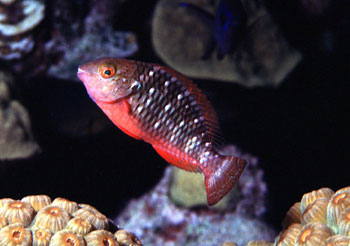
Dentition
S. viride teeth are fused, forming a pair of beak-like plates in each jaw. The lower plates slightly overlap the upper when the mouth is closed. Interlocking upper pharyngeals consist of rows of molariform teeth on a convex surface which come together against the molariform teeth on the concave surface of the lower pharyngeal.
Size, Age, and Growth
The stoplight parrotfish reaches lengths of 22 inches (55 cm) and weights of 3.5 pounds (1.6 kg). Initial phase females range in size from 100-367 mm while terminal phase males measure 7.0-14.6 inches(17.9-37.0 cm) in length.
Food Habits
These herbivorous reef fish graze on corals and algae growing on the surfaces of rocks throughout the reef. The strong beak-like fused teeth are used to bite off pieces of stony corals. It is not the hard coral skeleton that provides nourishment, but rather the coral polyps that grow on the surface of this skeleton. Living within these coral polyps are symbiotic algae called zooxanthellae. Coral skeletal material that is ingested by the parrotfish is crushed by the grinding motion of the pharyngeal mill, specialized teeth located in the throat. Afterwards, it makes its way through the fish’s digestive system and deposited on the reef as white coral sand. Parrotfish are known to return to the same area to release their waste products, forming hills of white sand. Parrotfish may produce as much as one ton of coral sand per acre of reef each year.

Reproduction
Parrotfish can undergo sex reversals during their life history. It is believed that sex changes occur when population densities are low, resulting in a lack of breeding males or females. Primary males are born male, and remain so throughout their lives while secondary males are born female, changing both sex and color to become male. These secondary males are also referred to as supermales or terminal males. Females and primary males, similar in appearance, are red, gray, brown, and black. Secondary males are bright green, blue, red, and yellow. Parrotfish spawn year round, over deep reef areas, with an increase in activity during the summer months. Secondary males pair with one female to spawn, while primary males mate in small groups containing one female and several males. After spawning, the adult fish return to shallow waters. The eggs are negatively buoyant and spherical, measuring 1 mm in diameter. After 25 hours, the fertilized eggs release larvae that are 1.4 mm in length with no eyes, mouth, or pigmentation. The mouth appears three days after hatching. Little is known about this larval stage.
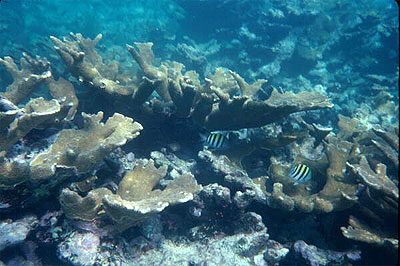
Predators
Snappers, jacks, and moray eels as well as other carnivorous fishes feed on the stoplight parrotfish.
Taxonomy
There are only 80 members in the family Scaridae, although earlier biologists identified over 350 species. The confusion resulted from the various color phases of each parrotfish.
Bonnaterre originally named this parrotfish Scarus viridis in 1788. He renamed it Sparisoma viride later that year. The genus name is derived from the Latin “sparus” = a fish with a golden head and the Greek “soma” = body. The species name viridis is Latin for green. One synonym used to refer to the stoplight parrotfish is Sparisoma albigaardi Bloch 1791. This name was used to describe the gray-red phase of the young adults that was thought to be a separate species. Another synonym is Scarus frondosus Agassiz 1829.
Prepared by: Cathleen Bester